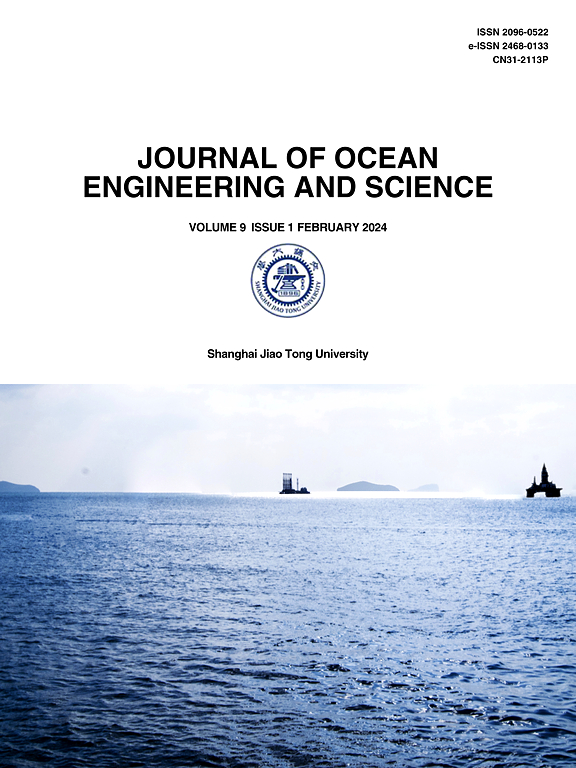Backscattering enhancements by partially exposed cylindrical shells due to reflected flexural waves at air–water interfaces
IF 11.8
1区 工程技术
Q1 ENGINEERING, MARINE
引用次数: 0
Abstract
For smooth curved objects in contact with a flat interface, the propagation paths of supported surface elastic waves can be altered by the interface, thereby enhancing the characteristics of the backscattered echo returns. In this study, backscattering experiments are conducted on an empty stainless steel cylindrical shell that breaks through an air–water interface and is insonified from below at grazing incidence. The shell has a thickness-to-radius ratio of 5%. The frequencies of interest fall within the vicinity of and below the coincidence frequency, which corresponds to a ka range of 13.8–20.1. The experimental results demonstrate that, for the partially exposed cylindrical shell, the flexural waves can traverse the interface and circumnavigate the shell multiple times. The flexural waves experience mode transitions upon passing through the interface, existing as a0− waves below the interface and a0 waves above the interface. Simultaneously, the flexural waves undergo partial reflection each time they pass through the interface, guiding them to follow a reverse path and generating a periodic series of echo returns, which leads to the enhancement of backscattering. The shift in resonance frequency in relation to the changing exposure is analyzed and predicted using the phase matching theory.
由于空气-水界面处的反射弯曲波,部分暴露的圆柱壳增强了后向散射
对于与平面界面接触的光滑曲面物体,受支撑的表面弹性波的传播路径可以被界面改变,从而增强了后向散射回波的特性。在这项研究中,在一个空的不锈钢圆柱壳上进行了后向散射实验,该壳穿过空气-水界面,在掠入射下从下面进行失谐。壳体的厚度-半径比为5%。感兴趣的频率落在重合频率附近或以下,对应于13.8-20.1的ka范围。实验结果表明,对于部分暴露的圆柱壳,弯曲波可以多次穿过界面并绕壳飞行。挠曲波通过界面后经历模态转变,在界面下方以a0−波存在,在界面上方以a0波存在。同时,弯曲波每次通过界面时都会发生部分反射,引导它们沿着相反的路径,并产生周期性的一系列回波,从而导致后向散射增强。利用相位匹配理论分析和预测了谐振频率随曝光量变化的变化。
本文章由计算机程序翻译,如有差异,请以英文原文为准。
求助全文
约1分钟内获得全文
求助全文
来源期刊

Journal of Ocean Engineering and Science
Multiple-
CiteScore
11.50
自引率
19.70%
发文量
224
审稿时长
29 days
期刊介绍:
The Journal of Ocean Engineering and Science (JOES) serves as a platform for disseminating original research and advancements in the realm of ocean engineering and science.
JOES encourages the submission of papers covering various aspects of ocean engineering and science.
 求助内容:
求助内容: 应助结果提醒方式:
应助结果提醒方式:


